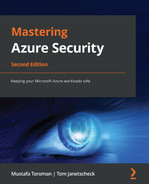Assessments
In the following pages, we will review all the practice questions from each of the chapters in this book and provide the correct answers.
Chapter 1 – An Introduction to Azure Security
- C. Responsibility is shared
- B. Cloud provider
- B. Cloud provider
- C. Depends on the service model
- A. User
- C. Both, but DLA is replacing Q10
- C. Customer is notified
Chapter 2 – Governance and Security
- D. All of the above
- C. We need to define both the what and the how
- C. Delete locks
- D. Management Group
- E. Management Group or Subscription
- D. All of the above
- B. A service to gather information about deployments
Chapter 3 – Managing Cloud Identities
- A. More exposed to attacks
- C. Password protection
- D. Passwordless sign-in methods
- A. Yes
- C. Infected users
- C. To activate privileges
- D. Passwordless authentication
Chapter 4 – Azure Network Security
- B. A Network Security Group (NSG)
- B. Site-to-Site
- C. Both of the above
- B. Service endpoints
- D. A and B are correct
- C. Distributed Denial of Service (DDoS)
Chapter 5 – Azure Key Vault
- E. All of the above
- B. Access policies
- A. Service principals
- A. EnabledForDeployment
- B. EnabledForTemplateDeployment
- C. EnabledForDiskEncryption
- C. Reference an Azure Key vault
Chapter 6 – Data Security
- B. Enforce HTTPS
- C. Blob soft delete
- A. Yes
- A. Yes
- A. Yes
- C. Both of the above
- B. Dynamic data masking
Chapter 7 – Microsoft Defender for Cloud
- C. Log Analytics Workspace
- A. Recommendations
- B. Logic Apps
- E. Both A and C
- D. Both B and C
- E. Both B and D
Chapter 8 – Microsoft Sentinel
- C. Security Information Event Management (SIEM)
- C. A Log Analytics workspace
- C. A variety of data connectors from different vendors
- C. Kusto
- A. Visual detection of issues
- B. Constant monitoring
- C. Analyzing data with Jupyter Notebooks
Chapter 9 – Security Best Practices
- D. Based on requirements, both A and B can be correct
- B. A firewall
- D. All of the above
- A. Access restriction
- B. Managed identity
- D. All of the above
- C. Different services and features
Assessments
Assessments
..................Content has been hidden....................
You can't read the all page of ebook, please click here login for view all page.
